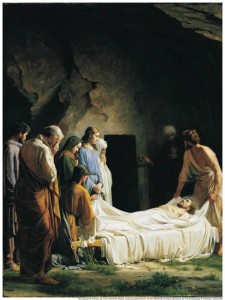There are two men in particular to thank for the proper, though hurried, burial of our Savior. If it weren’t for these two men Christ’s body would have been treated the same way as any other Jewish convicted criminal: tossed into a common grave. This was not a burial meant for the one who had just redeemed all of mankind.
 This occurred to Joseph of Arimathaea. Joseph was a rich man and a member of the Sanhedrin, the ancient Jewish court. His relationship to Jesus is uncertain, though some non-scriptural scholars have thought he might be the brother of Anna, Christ’s grandmother. It is more likely he was simply a devoted follower.
This occurred to Joseph of Arimathaea. Joseph was a rich man and a member of the Sanhedrin, the ancient Jewish court. His relationship to Jesus is uncertain, though some non-scriptural scholars have thought he might be the brother of Anna, Christ’s grandmother. It is more likely he was simply a devoted follower.
Joseph of Arimathaea went to Pilate, a ruler appointed by Rome, and asked to have the body of Jesus Christ released to him upon death. Though it seems a simple enough act, Joseph showed great courage. Not only could he have angered Pilate, he would also face the resentment of the Jewish leaders who originally sought the life of Christ and the court with which he served.
Pilate granted Joseph’s wish. Once death was declared Joseph went into action. Jewish law dictated that burial occur before the end of the day which was quickly approaching. Time didn’t allow for a proper burial in the sense of the body being appropriately anointed. All they could do was wash Him, wrap the head and body, and lay the body amid spices.
This is where we’re introduced to the second man who is only briefly mentioned at this time. Nicodemus, another ruler of the Jews (John 3:1) as a member of the Sanhedrin, had been a devoted follower of Christ, even in defending Him against the chief priests and Pharisees (John 7:45-52). He bought a large amount of spices, myrrh and aloe to prepare Jesus’ body for burial. The purchase was actually so large it was compared to that of what was used in royal burials, which I’m sure Nicodemus felt was appropriate.
These two men are those who took down the body of Jesus Christ. They removed the spikes from His hands, wrists, and feet. They lovingly washed His body clean, and did all that was needed in the short time available. I cannot picture the scene without seeing tears running down their faces, just as many of us who have grieved for our own loved ones who have passed on.
Jesus Christ was buried in Joseph of Arimathaea’s new tomb, freely given by this disciple (John 19:41-42). James E. Talmage, leader of the Church of Jesus Christ of Latter-day Saints (nicknamed the Mormon Church), sums up the next few events:
“The tomb was in a garden… Because of the nearness of the Sabbath the interment had to be made with haste; the door of the sepulchre was closed, a large stone was rolled against it; and thus laid away the body was left to rest” (Talmage, James E., Jesus the Christ, The Church of Jesus Christ of Latter-day Saints, 1981, p.665).
Only a few women followed, though they didn’t enter the tomb. Their Sabbath day was soon to begin and so they planned to come back in a few days to complete the anointing. Little did they know what scene would meet them the next time they would come to the Garden Tomb.


